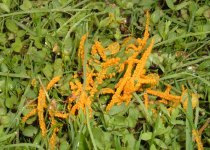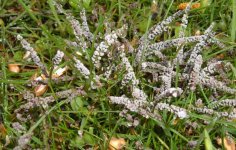rogerscoth
Well-known member
Firstly, I am not sure if this the correct category to include this thread, but it seemed the closest out of all the options.
Can anyone identify this formation (pics. below) that appears overnight in small patches on my small lawn grass in the (south facing) back garden.
Is it a fungi or maybe lichen? It starts off as bright yellow, then turns to grey within a few hours.
Roger
Can anyone identify this formation (pics. below) that appears overnight in small patches on my small lawn grass in the (south facing) back garden.
Is it a fungi or maybe lichen? It starts off as bright yellow, then turns to grey within a few hours.
Roger






